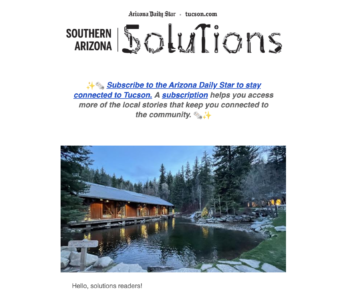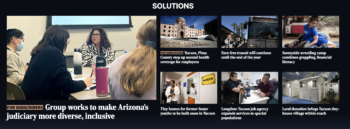4 benefits of engaging audiences with solutions journalism
Ashley Hopko, for API’s Better News,
A promotional flyer that includes a QR code to the survey that allows readers to suggest topics for Caitlin to write about.
Community feedback led the Arizona Daily Star to reevaluate how it covers community concerns, innovating toward a more positive, solutions-oriented lens.This is a series on Better News to a) showcase innovative/experimental ideas that emerge from the Knight-Lenfest Newsroom Initiative and b) share replicable tactics that benefit the news industry as a whole.
This “win” features highlights from a piece previously shared on BetterNews.org by Jill Jorden Spitz, former editor at the Arizona Daily Star, and Caitlin Schmidt, who was previously the Star’s solutions reporter and newsroom people and culture coordinator. The team participated in the Major Market Table Stakes program in 2021.
After the Arizona Daily Star received feedback from a reader who felt the organization was publishing negative stories about the Tucson community rather than sharing helpful information, the newsroom pivoted its coverage toward a collaborative version of solutions journalism.
The newsroom flipped the narrative and focused on the people, programs and processes working to fill equity gaps. The approach was a resounding success and didn’t require the publication to change its mission of producing investigative and watchdog content.
According to the Solution Journalism Network, solutions journalism typically includes the effective response to a social problem, as well as discussing limitations and other insights. Closely related, service journalism involves directly answering people’s questions and concerns, according to the Institute for Nonprofit News.

A screenshot of a solutions story
One example of a successful solutions-based story focused on a nonprofit that built tiny homes for unsheltered people, resulting in a 9-acre land donation.
To foster community buy-in, the Star’s staff, including the project’s primary reporter, Caitlin Schmidt, prepared a series of tools to introduce the new beat and encourage reader involvement. An initial column introduced the concept to readers who may have been unfamiliar with solutions journalism. Schmidt and the team then asked the audience about concerns within their communities and stories about people who are already working to solve issues.
Other successful engagement efforts included tabling at community events, handing out stickers, sending fliers to ZIP codes with a low number of subscribers and hosting virtual sessions to gather community coverage ideas.
Schmidt’s work continued gaining momentum, and she received several new idea submissions each time an article was published.
“We knew Tucson was a community of problem-solvers and helpers, but the feedback we receive from subjects in terms of donations and queries from prospective volunteers after their story was published just shows how much this community was craving coverage like this,” according to Schmidt and Jill Jorden Spitz, editor of the Arizona Daily Star.

A screenshot of the solutions page on the Arizona Daily Star’s website
The solutions journalism model had several other ripple effects:
Boosted reader engagement
The effort boosted readership and engagement. On average, the newsletter recruits 100 new subscribers per issue. People responded to articles, asking how they could get involved with certain efforts or initiatives. The team added a “how to get involved” button to solution-based stories in response.
Diversified topics and voices
Solutions journalism helped the Star diversify its coverage and fill long-standing gaps. For example, the staff was able to touch on mental health, substance use, housing insecurity and homelessness and criminal justice efforts. “Solutions stories also tend to include diverse sources, which is helping with the goal of our coverage being more reflective of our community,” the staff said. Beyond just readers and subscribers, the staff found that they were engaging with people outside of their typical realm of coverage.
Strengthened KPIs and metrics
KPIs including average reading minutes, social referrals and page visits on solutions journalism coverage are typically higher than that of other types of coverage. “The online version of a recent story on a former hotel now used as city-run housing for unsheltered individuals received more than 5,000 pageviews on the Fourth of July weekend,” the staff said.
Continued staff education
When Schmidt became a Solutions Journalism Network LEDE fellow, part of her work was passing on her institutional knowledge to the rest of the Arizona Daily Star staff. Several other Star journalists contributed. Six staffers took additional virtual training so they could incorporate solutions journalism into their beats.
You can read the full piece by Jill Jorden Spitz and Caitlin Schmidt here, or listen to a podcast interview with Caitlin below.